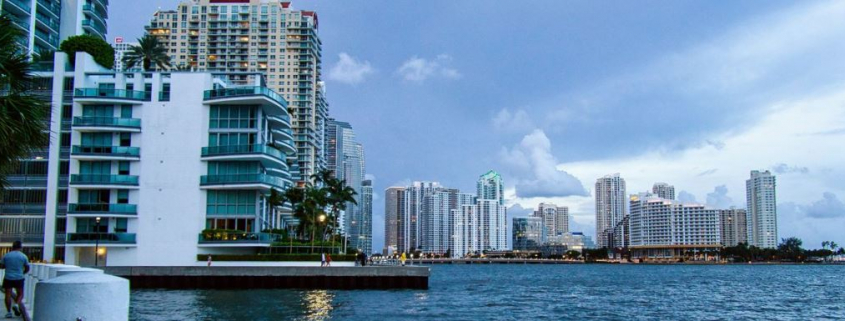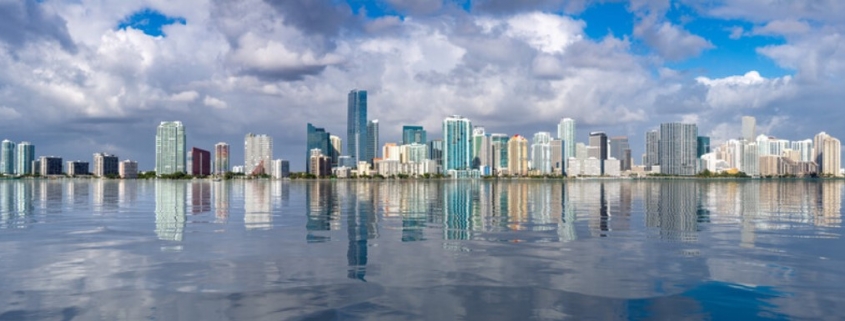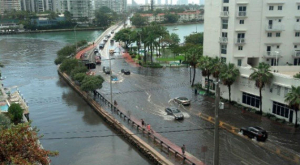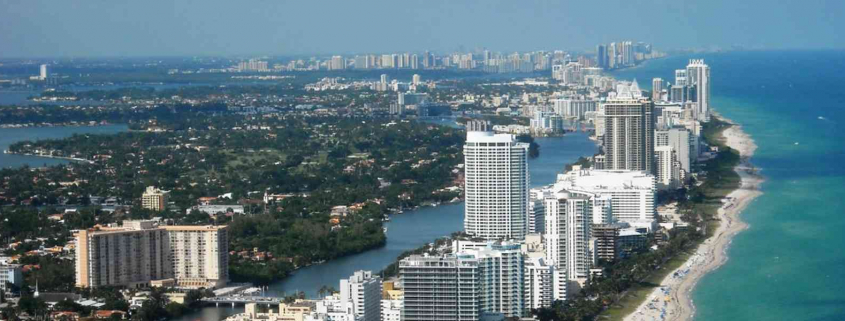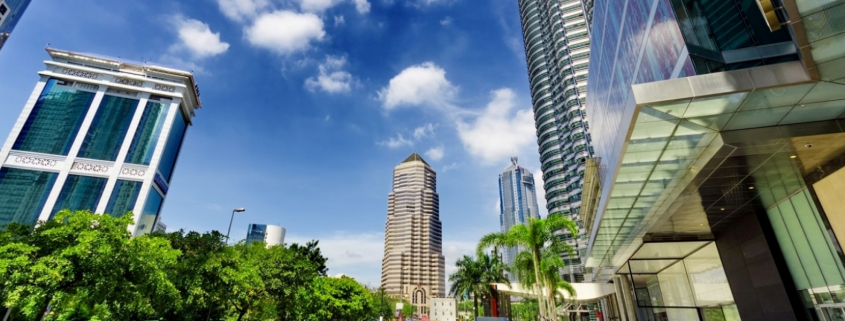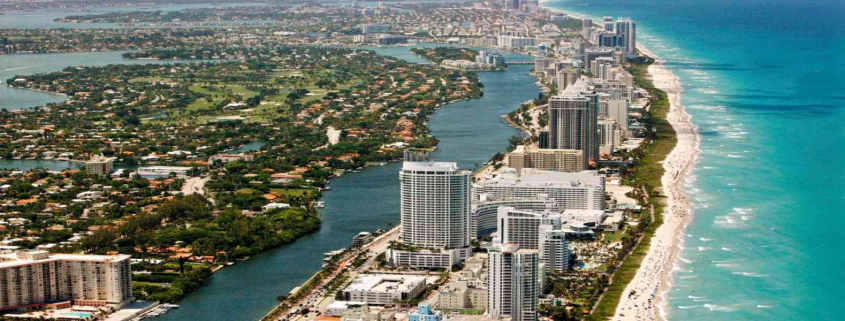From 2010 to 2020, the metro region’s population rose by more than 660,000, creating intense demand for offices, stores, hotels, and homes.
Posts
As more frequent and more intense storms bring destruction, they also present us with a chance to modernize.
Whereas some scientific fashions predict sufficient polar ice soften to convey no less than 10 ft of sea stage rise to South Florida by 2100, only a modest 12 inches would make 15% of Miami uninhabitable, and far of that beachside property is amongst America’s most beneficial.
Even now, as extra frequent “king tides” bubble up via Florida’s porous limestone, pushing fish via sewers and onto streets, residents are changing into extra conscious that their metropolis is constructed on the rippling cabinets, ridges and canyons of a fossil seabed.
“Water is just going again to the identical locations it flowed ages in the past,” says Sam Purkis, Chair of the College of Miami’s Geosciences Division. “The irony is what occurred 125,000 years in the past goes to dictate what occurs to your own home now.”
The fickle undulations between metropolis blocks might imply the distinction between survival and retreat, and the rising price of altitude is sparking a noticeable shift in neighborhood activism and municipal budgets.
Miami Seaside is spending hundreds of thousands elevating roads, upgrading pumps and altering constructing codes to permit residents to lift their mansions by 5 ft. However in working-class, immigrant neighborhoods like Little Haiti, year-to-year sea stage rise will get misplaced within the day-to-day wrestle, and most had no concept that they dwell a lofty three ft increased than the rich of us on Miami Seaside.
They came upon when builders began calling, from all over the place.
“They have been calling from China, from Venezuela. Coming right here with circumstances of cash!” says Marleine Bastien, a neighborhood organizer and longtime resident. “We used to assume that the attract of Little Haiti was the truth that it is near downtown, near each airports and near the seashore. Unbeknownst to us, it is as a result of we are positioned at the next altitude.”
Mentioning a row of vacant outlets, she ticks off the names of a dozen small enterprise homeowners she says have been compelled out by rising rents, and lists others who she says unwittingly took lowball presents with no understanding of Miami’s housing disaster.
“In case you promote your private home in Little Haiti, you assume that you simply’re making a giant deal, and it is solely after you promote, and then you definately understand, ‘Oh, I can’t purchase anyplace else.’”
After her neighborhood middle and day faculty have been priced out of three totally different buildings, she caught wind of plans to construct the sprawling $1 billion Magic Metropolis growth on the sting of Little Haiti, that includes a promenade, high-end retail shops, high rise residences and imagined by a consortium of native buyers, together with the founding father of Cirque du Soleil.
Magic Metropolis builders insist that they picked the location based mostly on location, not elevation. They promised to protect the soul of Little Haiti and provides $31 million to the neighborhood for inexpensive housing and different applications, but it surely wasn’t sufficient for Bastien.
“This can be a plan to really erase Little Haiti,” Bastien says. “As a result of that is the one place the place immigration and local weather gentrification collide.”
She fought the event with all of the protesters and hand-lettered indicators she might muster, however after a debate that went till 1 a.m., commissioners authorised the allow with a Three-Zero vote on the finish of June.
“The world we took was all industrial,” says Max Sklar, VP with Plaza Fairness Companions and a member of the event staff. “There was no actual thriving financial system round these warehouses or vacant land. And so our objective is to create that financial system. Can we appease all people? Not 100%, that is not possible. It is not sensible. However we have listened to them.”
He repeats a promise to ship $6 million to a Little Haiti neighborhood belief earlier than ground is even damaged and, as an indication that he listened to no less than one demand, acknowledges that the advanced will now be known as Magic Metropolis Little Haiti.
However whereas Bastien mourns the defeat, her neighbor and fellow organizer Leonie Hermantin welcomes the funding and hopes for the perfect.
“Even when Magic Metropolis didn’t come immediately, the tempo of gentrification is so speedy that our folks won’t be able to afford houses right here anyhow,” Bastien says with a resigned head shake. “Magic Metropolis is just not the federal government. Reasonably priced housing insurance policies have to return from the federal government.”
“Local weather gentrification is one thing that we are very intently monitoring,” Miami Mayor Francis Suarez tells me. “However we have not seen any direct proof of it but.”
Suarez is the uncommon Republican who passionately argues for local weather mitigation plans and helped champion the $400 million Miami Perpetually bond, authorised by voters to fund motion to guard the town from the ravages of upper seas and stronger storms.
“We really created in our first tranche of Miami Perpetually, a sustainability fund for folks to renovate their houses in order that they’ll keep of their properties somewhat than having to promote their properties,” Suarez says.
However that fund is a comparatively small $15 million, not sufficient to dent a housing disaster that grows with every warmth wave and hurricane, in a metropolis the place over 1 / 4 of residents dwell under the poverty stage.
Philip Alston, the UN Particular Rapporteur on excessive poverty and human rights, mentioned there was already proof of how the local weather disaster impacts the wealthy and poor in a different way. And he identified that these harm most have been seemingly these least accountable.
“Perversely, whereas folks in poverty are accountable for only a fraction of world emissions, they’ll bear the brunt of local weather change, and have the least capability to guard themselves,” Alston wrote final month.
Source: Nosy Media
Homes at higher elevations in Miami are gaining value at a faster clip than those closer to sea level.
It’s an accelerating trend, and it has residents and real estate agents — in Miami and other coastal communities — asking whether “climate gentrification” has arrived. The term, which only recently entered the lexicon, describes the role of climate change in recalibrating land values, a phenomenon that ultimately could displace low-income and minority residents in a similar fashion as urban gentrification. As sea levels rise and flooding persists, the thinking goes in the case of Miami, waterfront property will lose some of its luster and higher-situated neighborhoods like Little Haiti and Little Havana will become more attractive.
The professor who was first to publish research using the phrase “climate gentrification” isn’t convinced that’s the main culprit in Miami. At least not yet. Jesse M. Keenan, a researcher on urban development and climate adaptation at Harvard’s Graduate School of Design, tracked the rate of price appreciation since 1971 for more than 250,000 residential properties in Miami-Dade County, and compared those figures to elevation. Keenan found that properties at high elevations have long appreciated faster in Miami, mostly because of nonclimate factors.
However, since 2000, the correlation between elevation and price appreciation has grown stronger, which Keenan, in an interview with CBS MoneyWatch, suggested may be “early signaling” of preference for properties at higher elevations and a reaction to persistent nuisance flooding in lower areas.
His prediction: Over the next 10 years, climate change will become a more significant factor in the real estate market for many cities. He expects a “slow burn” toward a tipping point — similar to the foreclosure crisis — when all of a sudden values drop precipitously for high-risk properties.
“This is real,” Keenan said. “There are actual people spending lots of money thinking about how to make money from climate change. We have to come to terms with this sooner than later.”
Keenan tracks at least three “pathways” to climate gentrification, and the variations stem in part from the “location, location, location” mantra of real estate. The three scenarios:
- Low-risk properties surge in value, fueling a migration from high-exposure areas, causing displacement. This isn’t just a sea-level issue: California’s wildfires, for instance, are likely to lead to significant changes in how real estate is valued. “Anything related to climate change,” Keenan explained. “Low exposure is the determinate.”
- Living in high-exposure areas gets so expensive (think taxes, insurance, etc) that only rich people can live there, pushing historically mixed-income areas (such as Miami Beach, Florida, and Hampton Roads, Virginia) to become more exclusive.
- Government investments in resilience have the unintended consequence of boosting land and property values that wind up displacing populations. Sea-level fortifications on the Lower East Side of Manhattan could have this affect, Keenan said.
What’s at stake?
“People’s lives, their livelihoods and their culture,” said Mustafa Santiago Ali, senior vice president of climate, environmental justice and community revitalization for the Hip Hop Caucus, a nonprofit that connects the Hip Hop community to civic life.
Ali, who previously spent 24 years in various roles at the Environmental Protection Agency, said it’s fairly easy to predict who the winners will be as climate gentrification takes hold — led both by one-time events such as hurricanes and the more gradual process of sea-level rise. The answer, of course, is wealthier people.
“Who has the resources? Who has the access?” Ali asked in an interview with MoneyWatch. “Who has the education to understand what’s coming and navigate that?”
One key to ensuring a more equitable outcome is making sure communities are heard, are involved in development, including “adaptation” measures to accommodate climate change, and have avenues to take advantage of rising property values, Ali said. In fact, climate will be a focus area of a new initiative of the Hip Hop Caucus set for launch in spring that targets vulnerable communities.
In Miami, residents of some inland coastal neighborhoods that sit at comparatively high elevations, including Little Haiti, worry that rising property values fueled by sea-level increases could price them out, as PRI reported last week.
Developers have proposed three new projects in the Little Haiti neighborhood that could push immigrants and people of color out, activist Valencia Gunder told PRI.
“In Miami, historically because of racism, redlining and segregation, all of the brown and black people were forced to live in the center of the city, which also happens to be the high elevated areas,” she told PRI. “So, they pushed us here because they didn’t want us on the beach.”
For some buyers these days, the beach looks like a better place to visit than to live. And it’s not just coastal areas that could face consequences of “climate gentrification.” Coastal residents are likely to flock to inland cities in droves — with Austin, Texas; Orlando, Florida; and Atlanta likely to gain the most new residents, according to a study by Mathew Hauer published by the journal Nature in April.
The study, which considers a sea-level rise of about six feet by the year 2100, forecasts a migration of as many as 13 million people (double the total of the Great Migration), with more than 2.5 million fleeing the region that includes Miami, Fort Lauderdale and West Palm Beach. New Orleans would lose about 500,000 people, the study predicts, and the New York City area would lose 50,000 people.
That doesn’t mean coastal areas would empty out. History shows people will always want to live near the water, noted Joel Myers, founder and president of commercial weather service AccuWeather Inc.
Sea levels have been rising for thousands of years, he added, and even as that rise accelerates, the other side of the coin is there’s less waterfront land available to purchase. A simple formula of supply and demand.
Click here to view the CBS MoneyWatch video ‘Climate Gentrification Could Add Value To Elevation In Real Estate’
Source: CBS News
Parts of Miami Beach could be inundated with flood waters in as little as 15 years, and property values may slide amid the rising tide, according to nearly two dozen university heads and climate change experts who were on hand to answer questions on the effects of sea-level rise on South Florida during a Miami Beach Chamber of Commerce event at the W Hotel.
The purpose of the recent event, organized by land use and environmental attorney Wayne Pathman, was to warn business owners, developers, and contractors that the effects of sea-level rise will be impacting the property values fairly soon. Already, media around the globe are publicizing the fact that South Florida is “ground zero” for the adverse economic impact of sea-level rise, Pathman argued. Unfortunately, the region is still behind in preparing its infrastructure for the future.
“All eyes are upon us and South Florida isn’t ready,” said Pathman, co-founder of the Downtown Miami-based law firm of Pathman Lewis LLP and future chairman of the Miami Beach Chamber of Commerce.
Thanks to a slowing gulfstream, warming oceans, and ice flows submerging beneath the ocean from Greenland and Antarctica, the oceans are rising faster than ever, said Keren Bolter, research coordinator for Florida Atlantic University Center for the Environmental Studies. This has caused an increase in flooding events in recent years and it will only get worse. By 2100, the oceans are projected to increase by seven feet, Bolter added. At that level, The Keys, along with large chunks of Miami-Dade and Broward counties, will be inundated with sea water at high tide, destroying fresh water reserves, compromising underground sewage lines and septic tanks, and creating a host of other problems.
But you don’t have to wait 84-years to see the adverse effects of sea-level rise. Bolter said that in as little as 15 years, flooding in Belle Isle will grow much worse, especially at Island Terrace, a 16-story condo built in 1967. “It’s coming up not just at the sides,” she said while showing Lidar maps depicting future sea-level rise at Island Terrace and Belle Isle.
“It comes up from underground. That’s partly because the limestone that South Florida land is predominately made of us is extremely porous. Because of this, not even sea walls will stop the flow of water,” Bolter said. “By 2060 the oceans are projected to rise by two feet. At that level, “the western half of Miami Beach is under water.”
“As the oceans rise, the cost of insurance will skyrocket,” Pathman said. “Meanwhile, in an attempt to cope with the new reality, community leaders will raise taxes while property taxes are declining. As for the infrastructure of future residential and commercial projects, Miami Mayor Tomas Regalado recently declared on a radio show that the financial burden will fall on developers. However, at least some of the negative impacts of sea level rise can be mitigated if the business community takes a leadership role now. Many places around the world have already started adapting.”
Among the invited guests at the chamber event were Florida International University President Mark Rosenberg, Florida Atlantic University President John Kelly, and University of Miami’s Rosenstiel School of Marine and Atmospheric Science Dean Roni Avissar. They argued that their respective colleges are already training scientists and engineers who are not only studying the future effects of climate change, but also figuring out solutions on how communities like South Florida can adapt.
“We are very fortunate that we have a strong university system and a strong system of public education,” argued Matthew Welker, principal of MAST Academy at Florida International University’s Biscayne Bay campus. “That’s a very valuable resource.”
Josh Sawislak, global director of resilience for the Los Angeles-based engineering firm AECOM, said Miami could even replace Amsterdam as the true innovator of anti-flooding solutions.
“The brand can be, ‘This is a resilient city… Don’t go to Amsterdam to see how to prevent from being cut off by the sea, although they’ve got tasty cheeses. Come to Miami and see how to live with water,’” Sawislak declared.
One innovative idea has already been hatched in Miami. Rather than fight sea level rise, Bolter of FAU pointed out that “one student from the University of Miami” came up with the idea of simply making western Miami Beach “floodable” with the creation of new bays and living shorelines along with new boardwalks and flood-adapted buildings. (The UM student in question who developed that plan is Isaac Stein, who now works for the urban planning and landscape firm West 8.)
Besides speeches from experts, the event included an hour-long breakout session where business leaders sat at tables and asked questions to the assembled experts, some of whom flew in from other parts of the country to be there. The media, however, was ushered away from the session. Upon hearing that reporters were even present at the event, Donald Kipnis, founder and CEO of Brickell-based Development Service Solutions, walked out. Dozens of other chamber members left before the session even ended.
Harold Wanless, chair of the Department of Geological Sciences at the University of Miami, didn’t think the breakout session was long enough. Experts barely had 10 minutes to answer business leaders’ questions or lay out what needs to be done.
“We need to be planning, that is the bottom line,” said Wanless, who has long studied past sea-level rise events in Florida.
Following the breakout session, Jessica Goldman Srebnick, CEO of Goldman Properties, applauded the panel’s efforts. She also urged some restraint. Showing slides that show Miami Beach being submerged is what “gets picked up by the news.”
“We have to be very… strategic about how we discuss the reality of sea level rise,” Goldman said.
Pathman said the purpose of the event was just to “whet everyone’s appetite.” On September 14, the chamber plans to hold a roundtable discussion with “leading political and civic leaders about current and future strategies for sea level rise in South Florida” at a location to be announced.
Source: The Real Deal
It’s up to developers and city officials to protect projects in Miami Beach from the threat of global sea level rise, architect Reinaldo Borges warned an audience gathered inside a conference room at the W South Beach on Thursday.
“Developers need to change their perspective,” Borges said. “They go in with a short-term investment mentality. That mindset has to change.”
Borges, a principal of Borges & Associates Architects, lamented that hotel projects his firm worked on like the Royal Palm Miami Beach and the Bentley Beach Hotel will be negatively impacted by sea level rise. Before new projects break ground, Borges suggested city officials find ways to provide developers with incentives if they build structures at a higher elevation.
The Miami-based architect was part of a panel of business community leaders at the Miami Beach Community Resiliency Summit Friday morning. Other speakers such as Wendy Kallergis, president and CEO of the Greater Miami and the Beaches Hotel Association, and Gabriole Van Bryce, a member of the association’s sustainable hospitality council, talked about successful efforts to convince builders and owners to make their properties greener.
“We have really helped hotels reduce the impact of climate change by reducing greenhouse gas emissions,” Van Bryce said. “We want to further reduce the effects of greenhouse emissions by promoting a cool roof initiative to place local gardens on rooftops.”
Al Roker, host and weatherman for NBC’s “Today Show,” kicked off the summit by providing attendees with a few cold hard facts about climate change. “In the next 50 years, Miami’s high tide will be five feet higher,” Roker said. “At the city’s 100th anniversary concert last night, I told the crowd, ‘I hope you’re enjoying this now because where you are standing now will be underwater one day.’” The popular morning show personality also said the mainstream media made a mistake by coining the term “global warming,” instead of using “climate change.”
Following his presentation, Roker told The Real Deal that developers, city officials, and residents have to work together to address the real threat of climate change. “Everybody should be concerned,” Roker said. “Are buildings ready? Is the infrastructure ready? Those are all real concerns condo owners, private property owners, businesses and everybody should be concerned about.”
Source: The Real Deal
Several green building trends emerged over the past 12 months that will impact commercial real estate in the United States in 2015, according to Doug Lawrence, founder and managing principal of 5 Stone Green Capital—Bainbridge, an institutional real estate company.
Lawrence serves on the investment and natural resources committees of the University of Connecticut Foundation and the advisory board of Rutgers Business School.
Here’s what he foresees for emerging trends in green real estate in the year ahead.
1. Aging baby boomers and Gen X, Y and Z will continue to move to cities, requiring more affordable housing—and expecting it to be green.
 U.S. cities are growing faster than the suburbs. Baby boomers will need urban housing that supports their health and community needs, but so will the younger generations flocking to live in urban environments. As a policy matter, this means cities will be pressured to create housing that serves a wider range of income and age demographics. Affordable housing is likely to be the target of municipal agendas throughout the country.
U.S. cities are growing faster than the suburbs. Baby boomers will need urban housing that supports their health and community needs, but so will the younger generations flocking to live in urban environments. As a policy matter, this means cities will be pressured to create housing that serves a wider range of income and age demographics. Affordable housing is likely to be the target of municipal agendas throughout the country.
Green multifamily really wins within this demand picture. The ability to reduce overall operating expenses through green technology, therefore also reducing occupancy costs for tenants, should improve residential affordability. Green multifamily properties featuring optimal health designs will become increasingly attractive. These would include better air filtration systems to reduce dust, pollen and airborne pathogens that may trigger asthma; more daylighting to improve natural vitamin D production; and antibacterial countertops and doorknobs.
Expect multifamily vacancy rates to continue to fall for affordable and seniors housing sub-sectors. Absorption rates will remain solid for new multifamily construction. The 18-to-34-year-olds seem psychologically predisposed to green housing and, thanks to tight lending standards and high student loan debt, this group will not be seeking single-family homes in the near future. Thus, multifamily demand looks pretty good for 2015, and green multifamily will be the likely winner with the younger generations.
2. The anti-climate-change voices will yell even louder.
 Some naysayers will stop arguing that there is no increase in carbon dioxide (CO2) in our atmosphere. Instead, they will argue that increasing CO2 is good for the global economy because CO2 is necessary to increase agriculture. Under this theory, more CO2 in the atmosphere would mean a golden age for crop production. Green real estate investors will continue to reduce their carbon footprint under the belief that doing so increases profitability and is good for the environment as well.
Some naysayers will stop arguing that there is no increase in carbon dioxide (CO2) in our atmosphere. Instead, they will argue that increasing CO2 is good for the global economy because CO2 is necessary to increase agriculture. Under this theory, more CO2 in the atmosphere would mean a golden age for crop production. Green real estate investors will continue to reduce their carbon footprint under the belief that doing so increases profitability and is good for the environment as well.
3. Renewable technology, particularly solar, will continue to fall in price and improve in efficiency.
 Solar panels that can convert up to 70 percent of the sun’s light spectrum into electricity (from gamma rays to X-rays) are already in beta testing. This could be a game-changer for real estate owners, especially in the multifamily and industrial sectors, as well as for those with properties in dense urban environments in high-cost electricity states.
Solar panels that can convert up to 70 percent of the sun’s light spectrum into electricity (from gamma rays to X-rays) are already in beta testing. This could be a game-changer for real estate owners, especially in the multifamily and industrial sectors, as well as for those with properties in dense urban environments in high-cost electricity states.
The cost of solar energy could fall below that of fossil fuel-generated electricity per kilowatt hour, even with the drop in oil and/or gas prices. As technology improves, real estate managers will explore new ways to provide energy to tenants and users at more efficient prices.
4. Urban resiliency and climate change will become topics for deeper discussion among policy-makers.
 Following rising average sea levels in a wide range of American cities—from Los Angeles to Galveston, Texas to New York and Boston—and more frequent and more damaging storms, cities are becoming very focused on hardening essential infrastructure.
Following rising average sea levels in a wide range of American cities—from Los Angeles to Galveston, Texas to New York and Boston—and more frequent and more damaging storms, cities are becoming very focused on hardening essential infrastructure.
The real estate industry may see new building codes that emphasize sustainability, as well as resiliency.
5. Utilities companies and smart developers will form partnerships for distributed generation.
 It’s getting harder and harder to build new power plants, yet we have more people for whom to provide electricity; meanwhile, business demand for electricity is increasing as the economy strengthens. U.S. power plants are not only aged, but also use incredibly large amounts of fresh water for cooling. Moreover, some experts predict that as much as 10 percent of coal-fired electricity-generating plants in the United States may be shut down over the next few years. More demand, coupled with fewer production resources, may spur real estate owners and power companies into an alliance.
It’s getting harder and harder to build new power plants, yet we have more people for whom to provide electricity; meanwhile, business demand for electricity is increasing as the economy strengthens. U.S. power plants are not only aged, but also use incredibly large amounts of fresh water for cooling. Moreover, some experts predict that as much as 10 percent of coal-fired electricity-generating plants in the United States may be shut down over the next few years. More demand, coupled with fewer production resources, may spur real estate owners and power companies into an alliance.
The concept of distributed generation, wherein solar-powered rooftops are used to create renewable energy that feeds the grid, will become more attractive. In this way, the utility company will gain a production source to feed growing demand without having to go through nightmarish public hearings to obtain the production increase. Meanwhile, the real estate owner may see a new revenue stream, or at least a reduction in energy consumption. All in all, partnerships between developers and utility companies may reduce overall operating expenses for garages, public areas, elevators and other electrical hot points.
6. The sharing economy will continue to grow.
 Sharing economy enterprises are thriving, particularly in urban markets. Think office sharing, or even Airbnb.com. These phenomena are no longer fads, and they are changing how we think about office space, hoteling and more.
Sharing economy enterprises are thriving, particularly in urban markets. Think office sharing, or even Airbnb.com. These phenomena are no longer fads, and they are changing how we think about office space, hoteling and more.
Many experts assume that the more we share, the less stress we will have on the environment, but it may still be too early to tell whether that’s true.
7. Food production will become more urban and commercial buildings’ rooftops will increase in value.
 It’s becoming less profitable to truck a tomato from California to New York and, due to the increasing demand for locally-grown produce, the term “farm-to-table” has become embedded in our vocabulary. The demand for food that is grown without pesticides, fungicides or other chemicals is increasing. We already see grocers like Whole Foods establishing hydroponic farms on their rooftops. Such production reduces transportation costs and improves produce freshness and variety. Other grocers, including Safeway, have gone green by deploying solar arrays and other renewable energy technologies on their stores’ rooftops in order to reduce peak-demand electricity charges. Large rooftops will therefore continue to find new value as non-traditional tenants begin to use them in new ways.
It’s becoming less profitable to truck a tomato from California to New York and, due to the increasing demand for locally-grown produce, the term “farm-to-table” has become embedded in our vocabulary. The demand for food that is grown without pesticides, fungicides or other chemicals is increasing. We already see grocers like Whole Foods establishing hydroponic farms on their rooftops. Such production reduces transportation costs and improves produce freshness and variety. Other grocers, including Safeway, have gone green by deploying solar arrays and other renewable energy technologies on their stores’ rooftops in order to reduce peak-demand electricity charges. Large rooftops will therefore continue to find new value as non-traditional tenants begin to use them in new ways.
8. Mortgage finance and insurance organizations will consider green standards.
 As the government-sponsored entities Freddie Mac and Fannie Mae continue reviewing and improving their standards for green buildings, other mainstream lenders and insurance companies will catch up with the trend. Insurance companies will see green buildings as a way to reduce risk. Lenders will potentially see lower volatility in net operating cash flows. As the capital markets go green, so will more building owners and investors.
As the government-sponsored entities Freddie Mac and Fannie Mae continue reviewing and improving their standards for green buildings, other mainstream lenders and insurance companies will catch up with the trend. Insurance companies will see green buildings as a way to reduce risk. Lenders will potentially see lower volatility in net operating cash flows. As the capital markets go green, so will more building owners and investors.
The Dow Jones Sustainability Index is proving that green business outperforms the non-green Dow Jones Industrials Index. Green building will mimic that outperformance and, as a result, gain momentum in 2015.
Source: NREI
As a city sitting virtually at sea level, Miami has been called ground zero for the problems posed by climate change, a place where rising sea levels threaten its future existence.
The latest forecast of sea level rise from the Intergovernmental Panel on Climate Change, for example, predicts that by later this century, global sea levels will be two feet higher than they are today, quite possibly higher. Under that scenario, the nuisance flooding in Miami that periodically comes with high tides will be a daily affair, the storm surge impact of hurricanes will be amplified, and lower-lying areas of the city will be uninhabitable. That’s actually not the worst of it: Under higher sea levels, the Biscayne Aquifer—where southeast Florida draws its drinking water—will increasingly suffer from saltwater intrusion, a problem for which there is no foreseen solution other than the investment of billions of dollars in water treatment facilities.
As bleak as this future would seem to be, few with real skin in the game in Miami—residents, real estate investors, and companies—are backing away from long-term investment. Exhibit A: Miami has been undergoing a nearly unprecedented surge in real estate construction, with planning discussions centering less on who will leave first and more on how high new projects can be built. Among the projects under way, for example, is an 80-plus-story behemoth in Brickell Center, the city’s urban core. If Miami is on the verge of being a modern-day Atlantis, those who would have the most to lose are apparently not buying it.
Why this apparent deafness to the dire warnings? Well, here’s a paradox. If one talks to developers and city commissioners in the area, it’s hard to find evidence of overt denial of current and future risk; Miami was a city, after all, almost completely destroyed by a hurricane in 1926, and most concede that a recurrence is a matter of when, not whether. Likewise, few deny that the city’s unique geography makes it vulnerable to the effects of rising sea levels. It’s a long-term problem that the planning commissions of Miami and Miami Beach acknowledge exists and threatens to get worse.
Where locals disagree with outsiders, however, is about how best to deal with the problem. Rather than sounding alarms and cutting back on development, there’s an implicit sense that the best approach may be, ironically, to do the opposite. And while a strong case can be made that this behavior has no rational basis, it may represent Miami’s best long-term hope for dealing with the threats posed by climate change, one that other cities might be advised to mimic: The best strategy, in fact, may be to foster a collective belief that there’s no threat—or at least not one serious enough to lose sleep over.
Before an explanation why, let’s first address the two standard explanations for the building boom, explanations that are indeed part of the puzzle. The first is that real estate developers, by their nature, are gamblers with short planning horizons. In the late 2000s, the real estate and equities crash quickly wiped out many builders. One might assume that would have made them skittish. To the contrary, the quick recovery that followed taught most that big risks are worth taking, and are survivable. While developers today may concede that sea levels are rising, it’s a risk that lies well beyond their investment horizons, and in any case is dwarfed by the more immediate risk of a returning recession.
The second explanation is that many of the buyers for all the new condo units are cash investors from Latin America, and the risks of Miami real estate—overdevelopment, speculation, environmental unsustainability—remain small relative to similar investments back home. No one is saying that real estate isn’t risky in Miami, or that sea level rise is fiction. What they are saying is that all investment carries risk, and development there is a bet they’re prepared to take.
But there’s another rational reason why even risk-averse residents in South Florida might, paradoxically, hope that buyers and sellers remain collectively naïve, or at least act as if they are, about the risks of sea level rise. South Florida relies almost exclusively on real estate taxes to fund public infrastructure. If the threat (or reality) of sea level rise suppresses property valuations, there will be less public money to address the risk. As an illustration, the head of public works for Miami Beach recently argued that the city would be wise to accelerate its investments in storm water drainage improvements ($100 million now and $400 million planned) simply because the city has the tax base to afford it—something it could not necessarily count on in the future.
Because buyers and sellers in Miami Beach have yet to connect the dots between nuisance flood events and the future consequences of sea level rise, property buyers continue to be drawn to the area, and development projects continue unabated—both of which are essential for a continued healthy tax base. If and when buyers and sellers do connect the dots, everything changes: Doing so could spark a rapid downward wealth spiral that, once initiated, would be difficult to reverse. Lowering property valuations would reduce the city’s tax revenue which, in turn, would leave it with less money to shore up the city against sea level rise. The city would then be forced to choose between two losing remedies: increase taxes on those who choose to stay, or decline to make the needed improvements. Both, of course, would only exacerbate the problem. Miami’s best move at that point would be to go hat in hand to the state and federal government for a bailout, but that seems unlikely. Quite aside from the “I-told-you-so” reactions that such pleas might evoke, almost all coastal communities would be facing similar problems and asking for commensurate help. Miami Beach as we know it now could cease to exist long before the Atlantic reclaims Collins Avenue.
Given this, South Florida’s best shot at coping with the long-term environmental threat may be a strategy that no doubt seems perverse to environmentalists: aggressively foster a collective belief that sea level rise is not something we urgently need to worry about. South Florida is potentially facing a huge adaptation bill down the road, and paying for it will require a healthy tax base. Keeping that tax base flush depends on a cooperative equilibrium where buyers and sellers maintain an optimistic view that it’s tomorrow’s problem, one that will be easily tackled when the time comes. This keeps the coffers filled and provides the resources needed to pay for the engineering adaptations required to keep the game going.
In this light, Miami’s construction cranes aren’t monuments to climate change denial. Quite to the contrary—they’re the instruments that may, indirectly, allow the city to survive global warming. Controlled ignorance, in some cases, can be a good thing.
Source: Bloomberg Businessweek
About Us
Ven-American Real Estate, Inc. established in 1991, is a full service commercial and residential real estate firm offering brokerage and property management services.
Subscribe
Contact Us
Ven-American Real Estate, Inc.
2401 SW 145th Avenue, Ste 407
Miramar, FL 33027
Brokerage & Property Management Services
Phone: 305-858-1188

